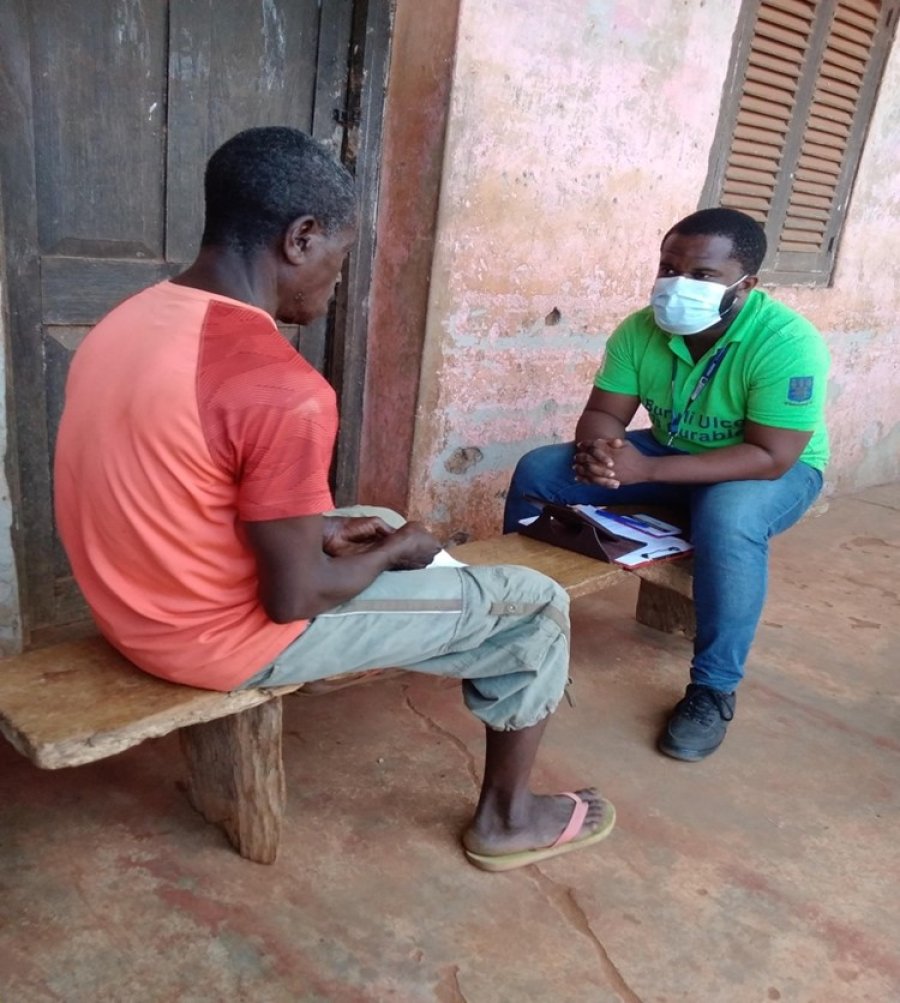
Photo Caption: A SHARP researcher interviews an individual affected by BU. Credit: SHARP
Members of SHARP, including researchers from the Global Health Economics Centre at the London School of Hygiene & Tropical Medicine, showed that Neglected Tropical Diseases (NTDs) of the skin can have significant financial and economic burdens on individuals and households, particularly the poorest, both through the direct costs of care-seeking and loss of income.
The study, published in Social Science and Medicine, expands on existing research by examining the impacts of multiple diseases (Buruli ulcer, leprosy, and cutaneous leishmaniasis) in different contexts (Ghana and Ethiopia), revealing that the direct costs of care-seeking and productivity losses vary by disease and country context.
Researchers conducted interviews and focus group discussions with affected individuals, caregivers, and community members to better understand the role of economic factors in individuals’ experiences of skin NTDs. In both countries, individuals affected by skin NTDs reported substantial financial costs to obtain care. This included payments for transport to get to health facilities and for medical supplies.
Dr Yohannes Hailemichael, co-first author of the study and postdoctoral health economist at the Armauer Hansen Research Institute said: “Ghana and Ethiopia both have some form of public health insurance scheme designed to provide financial risk protection. However, we found important gaps between design and practice for skin NTDs. Unreliable stock supplies meant individuals often had to pay out of pocket for medications and medical supplies that were supposed to be covered by insurance. Also, the costs of traveling long distances to hospitals wasn’t covered by insurance and could be a major barrier and burden for households.”
For many skin NTDs, prompt and effective treatment can lead to a total cure or prevent or limit scarring and disability. SHARP heard from study participants that costs affected their care-seeking choices. Some individuals explained how the cost of transport could be significant enough to put off or avoid treatment, even if the potential consequences were very serious.
Dr Jacob Novignon, co-first author of the study and senior lecturer in health economics at the Kumasi Center for Collaborative Research in Tropical Medicine (KCCR) said: “Our study reveals the importance of economic burdens in shaping care-seeking choices, and the knock-on effects of these choices, which create negative feedback loops that exacerbate the skin NTD burden and makes poor and marginalised households particularly vulnerable.”
In Ghana and Ethiopia, care from traditional healers was considered more affordable than care from formal providers. Traditional healers lived locally and sometimes conducted home visits, reducing transport costs, and offered flexible payment arrangements.
Importantly, in both countries, many of the traditional mechanisms of informal risk-pooling and community support were dependent on social connections which poorer families did not always have.
Economic impacts extended beyond the direct costs involved with seeking and maintaining treatment. There were also significant costs to some households in the form of opportunity costs, which can stem from harmful coping strategies.
Some participants were unable to work or attend school. Skin NTDs often come with pain, discomfort, or loss of function, limiting affected individuals’ ability to carry out their usual work or activities. For others, productivity was reduced for household members who accompanied the affected individual during care-seeking or stayed home to provide care and support.
From these findings, SHARP developed a conceptual framework, a layered representation of how different economic factors form part of the burden of skin NTDs and also create feedback loops that can exacerbate both the health and economic burden.
Dr Catherine Pitt, senior author of the study and an Associate Professor of Health Economics at LSHTM said: “I hope this work helps to change how the NTD community thinks about NTD interventions. There used to be an idea that ‘economic interventions’ for NTDs were just about support for livelihoods for people with permanent disabilities or scarring. Our findings now show the huge upstream opportunities for people interested in health systems.
“If interventions can address the economic barriers that stop people from obtaining prompt and effective treatment, then they could help to reduce the risk of developing disabilities in the first place. Our conceptual framework helps communicate this different way of thinking about the economics of skin NTDs.”
This conceptual framework has already been used to inform the design of intervention strategies within SHARP, targeting key drivers of economic burden at multiple levels.
If you enjoyed this article and would like to build a career in global health, we offer a range of MSc programmes covering health and data, infectious and tropical diseases, population health, and public health and policy.
Available on campus or online, including flexible study that works around your work and home life, be part of a global community at the UK's no.1 public health university.
